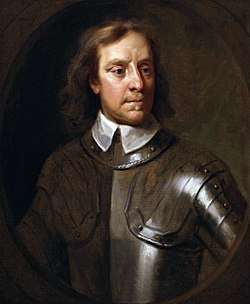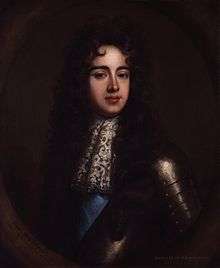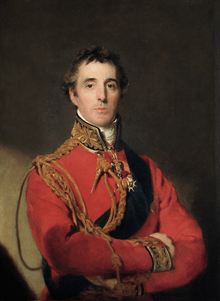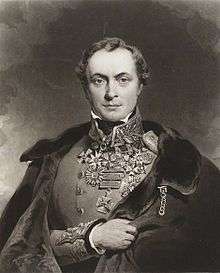Commander-in-Chief of the Forces
The Commander-in-Chief of the Forces, later Commander-in-Chief, British Army, or just the Commander-in-Chief (C-in-C), was (intermittently) the professional head of the English Army from 1660 to 1707 (the English Army, founded in 1645, was succeeded in 1707 by the new British Army, incorporating existing Scottish regiments) and of the British Army from 1707 until 1904.
| Commander-in-Chief of the Forces | |
|---|---|
| English Army British Army War Office | |
| Type | Senior-most officer |
| Abbreviation | C-in-C |
| Reports to | Secretary of State for War |
| Appointer | The Monarch |
| Term length | No fixed term |
| Formation | 1645 January 1793 |
| First holder | Captain General Sir Thomas Fairfax as General-in-Chief FM Jeffery Amherst, 1st Lord Amherst as Commander-in-Chief of the Forces |
| Final holder | FM Frederick Roberts, 1st Earl Roberts |
| Abolished | 12 February 1904 |
| Succession | Chief of the General Staff |
In earlier times, supreme command of the Army had been exercised by the monarch in person. After 1660 it became rare for British sovereigns to lead their troops in battle (with the notable exception of King William III); instead, it became normative for command (especially in time of war) to be delegated to an individual, who usually held the appointment of Captain General or Commander-in-Chef of the Forces.[1] (In early years these two titles were often used interchangeably, and/or the appointments were held concurrently). The office was not always filled: for example, James II and William III both functioned themselves as Commander-in-Chief; at other times the appointment simply lapsed (especially if there was no perceived immediate military threat.[1]
In most instances, Commanders-in-Chief of the Forces were not Cabinet members (only Conway and Wellington had a seat in Cabinet by virtue of holding this office; Ligonier and Granby were also in Cabinet during their time in office, but in both cases sat as Master-General of the Ordnance).[1] Instead, the British Army was represented variously and tenuously in government by the Paymaster of the Forces (Paymaster General from 1836), the Master-General of the Ordnance (who did not invariably have a seat in Cabinet), the Secretary at War (who was not usually a member of the Cabinet) and (from 1794) the Secretary of State for War.
The appointment of Commander-in-Chief remained in the personal gift of the monarch, and its independence was guarded by Queen Victoria (among others) as emblematic of the notion that command of the Army was vested in the Crown; during her reign, however, the office was (in 1870) made much more clearly subordinate to the Secretary of State for War (and to Parliament).[2]
The office was replaced in 1904 with the creation of the Army Council and the appointment of Chief of the General Staff. The title reverted to the monarch, who remains (titular) "Commander-in-chief of the British Armed Forces".[3]
Republican origins
In 1645, after the outbreak of the English Civil War, Parliament appointed Thomas Fairfax "Captain General and Commander-in-Chief of all the armies and forces raised and to be raised within the Commonwealth of England".[4] Thomas Fairfax was the senior-most military officer, having no superior, and held great personal control over the army and its officers. Lord Fairfax was styled "Lord General". None of his successors would use this title. In 1650, Fairfax resigned his post, shortly before the Scottish campaign of the War.[5]
Oliver Cromwell, Fairfax's Lieutenant-General, succeeded him as Commander-in-chief of the Forces.[5] Under Cromwell, the Commander-in-Chief was de facto head of state, especially after the dismissal of the Long Parliament. Cromwell held the office until 1653, when he was elected Lord Protector.[6]
On 21 February 1660, the reconstituted Long Parliament resolved "that General George Monck be constituted and appointed Captain-General and Commander in Chief, under Parliament, of all the Land-Forces of England, Scotland and Ireland".[7]
Post-Restoration origins
After Monck's death, the post, which gave the holder significant military power, was abolished until James Scott, 1st Duke of Monmouth successfully petitioned Charles II and was granted it in 1674.[8] After Monmouth's execution the post was again not filled until 1690, when it was bestowed upon John Churchill, Earl of Marlborough, during the King's absence in Ireland.[9] It was likewise conferred on Meinhardt Schomberg, Duke of Schomberg the following year during the King's absence in Flanders, Marlborough having fallen from favour.[10]
Later history
With the appointment of General Lord Jeffrey Amherst in 1793, the Commander-in-Chief was given authority over matters of discipline, over supplies, training and promotions in the British Army. The establishment of a military staff took place under the oversight of his successor, Frederick, Duke of York.[11]
With the demise of the Board of Ordnance in the wake of the Crimean War the Commander-in-Chief assumed command of the Ordnance troops: the Royal Regiment of Artillery and the Corps of Royal Engineers. The momentum of reform at this time, however, was toward increasing the authority of the Secretary of State for War. From the passing of the War Office Act 1870, as part of the Cardwell Reforms, the Commander-in-Chief was made clearly subordinate to the Secretary of State, to serve as the latter's principal military adviser, and was made to move out of his traditional office above the arch at Horse Guards and into the War Office. Nevertheless, in 1888 he is still described as having responsibility for all personnel and matériel issues for the army and auxiliary forces, and in 1895 he took on the responsibilities of chief of staff.[11]
The post was finally abolished by recommendation of the Esher Report, set up in the wake of the Second Boer War, which established the office of Chief of the General Staff.[11]
Appointees
The following table lists all those who have held the post of Commander-in-Chief of the Forces or its preceding positions. Ranks and honours are as at the completion of their tenure:
† denotes people who died in office.
| No. | Portrait | Name | Took office | Left office | Time in office | Ref |
|---|---|---|---|---|---|---|
| Parliamentary General-in-Chief Command | ||||||
| 1 | Captain General Sir Thomas Fairfax (1612–1671) | 1645 | 1650 | 4–5 years | [4] | |
| 2 | Captain General Oliver Cromwell (1599–1658) | 1650 | 1653 | 2–3 years | [5] | |
| General-in-Chief Command | ||||||
| 1 | Captain General George Monck, 1st Duke of Albemarle (1608–1670) | 3 August 1660 | 3 January 1670 † | 9 years, 153 days | [12] | |
| Position vacant (3 January 1670 – 30 March 1674) | ||||||
| 2 | General James Scott, 1st Duke of Monmouth (1649–1685) | 30 March 1674 | 1 December 1679 | 5 years, 246 days | [13] | |
| Position vacant (1 December 1679 – 3 June 1690) | ||||||
| 3 | General John Churchill, 1st Earl of Marlborough (1650–1722) | 3 June 1690 | 30 April 1691 | 331 days | [9] | |
| 4 | General Meinhardt Schomberg, 3rd Duke of Schomberg (1641–1719) | 30 April 1691 | 1691 | 0 years | [10] | |
| Position vacant (1691 – 24 April 1702) | ||||||
| (3) | General John Churchill, 1st Earl of Marlborough (1650–1722) | 24 April 1702 | 1711 | 8–9 years | [9][14] | |
| 5 | General James Butler, 2nd Duke of Ormonde (1665–1745) | 1 January 1711 | 1714 | 2–3 years | [15] | |
| (3) | General John Churchill, 1st Earl of Marlborough (1650–1722) | 1714 | 1722 | 7–8 years | [1] | |
| Position vacant (1714 – 1 January 1744) | ||||||
| 6 | Field Marshal John Dalrymple, 2nd Earl of Stair (1673–1747) | 1 January 1744 | 1744 | 0 years | [16] | |
| 7 | Field Marshal George Wade (1673–1748) | 1744 | 1745 | 0–1 years | [17] | |
| Position vacant (1745 – 1745) | ||||||
| 8 | General Prince William, Duke of Cumberland (1721–1765) | 1745 | 24 October 1757 | 11–12 years | [18] | |
| 9 | Field Marshal John Ligonier, 1st Earl Ligonier (1680–1770) | 24 October 1757 | 1759 | 1–2 years | [19] | |
| Position vacant (1759 – 13 August 1766) | ||||||
| 10 | Lieutenant-General John Manners, Marquess of Granby (1721–1770) | 13 August 1766 | 1769 | 2–3 years | [20] | |
| Position vacant (1769 – 19 March 1778) | ||||||
| 11 | Field Marshal Jeffery Amherst, 1st Baron Amherst (1717–1797) | 19 March 1778 | 29 March 1782 | 4 years, 10 days | [21] | |
| 12 | Field Marshal Henry Seymour Conway (1721–1795) | 29 March 1782 | 21 January 1793 | 10 years, 298 days | [22] | |
| Commander-in-Chief | ||||||
| 1 | Field Marshal Jeffery Amherst, 1st Lord Amherst (1717–1797) | January 1793 | February 1795 | 2 years, 31 days | [23] | |
| 2 | Field Marshal Prince Frederick, Duke of York (1763–1827) | 3 April 1795 | 25 March 1809 | 13 years, 356 days | [24] | |
| 3 | General Sir David Dundas (1735–1820) | 1809 | 1811 | 1–2 years | [25] | |
| (2) | Field Marshal Prince Frederick, Duke of York (1763–1827) | 29 May 1811 | 5 January 1827 † | 15 years, 221 days | [26] | |
| 4 | Field Marshal Arthur Wellesley, 1st Duke of Wellington (1769–1852) | 22 January 1827 | 22 January 1828 | 1 year, 0 days | [27] | |
| 5 | General Rowland Hill, 1st Lord Hill (1772–1842) | 22 January 1828 | 15 August 1842 | 14 years, 205 days | [28] | |
| (4) | Field Marshal Arthur Wellesley, 1st Duke of Wellington (1769–1852) | 15 August 1842 | 14 September 1852 † | 10 years, 30 days | [29] | |
| 6 | Field Marshal Henry Hardinge, 1st Viscount Hardinge (1785–1856) | 28 September 1852 | 5 July 1856 | 3 years, 281 days | [30] | |
| 7 | Field Marshal Prince George, Duke of Cambridge (1819–1904) | 5 July 1856 | 1 November 1895 | 39 years, 119 days | [31] | |
| 8 | Field Marshal Garnet Wolseley, 1st Viscount Wolseley (1833–1913) | 1 November 1895 | 3 January 1901 | 5 years, 63 days | [32] | |
| 9 | Field Marshal Frederick Roberts, 1st Earl Roberts (1832–1914) | 3 January 1901 | 12 February 1904 | 3 years, 40 days | [33] | |
References
- Roper, Michael (1998). The Records of the War Office and Related Departments, 1660-1964. Kew, Surrey: Public Record Office.
- Forbes, Major-General A. (1929). A History of the Army Ordnance Service. Volume II: Modern History. London: The Medici Society. pp. 20–21.
- Hughes, Matthew; Seligmann, Matthew (1990). Leadership in Conflict: 1914-1918. Barnsley, S. Yorks.: Leo Cooper. p. 249.
- Lingard, John (1829). A History of England from the First Invasion by the Romans. XI. Baldwin and Cradock. p. 447.
-

- Gaunt 1996, p. 155
- Journals of the House of Commons, volume eight. London: HM Stationery Office. 1813. p. 847.
- Roberts, George (1844). The Life, Progresses and Rebellion of James, Duke of Monmouth. London: Longman, Brown, Green and Longmans. p. 36.
- "John Churchill, 1st Duke of Marlborough". Oxford Dictionary of National Biography. 2004. doi:10.1093/ref:odnb/5401. Retrieved 21 January 2014.
- "Meinhardt Schomberg, 3rd Duke of Schomberg". Oxford Dictionary of National Biography. 2004. doi:10.1093/ref:odnb/24825. Retrieved 21 January 2014.
- Raugh, Harold E. (2004). The Victorians at War, 1815-1914: an Encyclopaedia of British Military History. Santa Barbara, California: ABC-CLIO Inc.
- Hutton, Ronald (2004). "George Monk". Oxford Dictionary of National Biography. doi:10.1093/ref:odnb/18939. Retrieved 21 January 2014.
- "James Scott, 1st Duke of Monmouth". Oxford Dictionary of National Biography. 2004. doi:10.1093/ref:odnb/24879. Retrieved 21 January 2014.
- "John Churchill, 1st duke of Marlborough". Encyclopaedia Britannica. Retrieved 18 December 2019.
- "No. 4948". The London Gazette. 3 January 1711. p. 1.
- "John Dalrymple, 2nd Earl of Stair". Oxford Dictionary of National Biography. 2004. doi:10.1093/ref:odnb/7053. Retrieved 21 January 2014.
- Heathcote 1999, p. 286
- Speck, W. A. (2004). "Prince William, Duke of Cumberland". Oxford Dictionary of National Biography. doi:10.1093/ref:odnb/29455. Retrieved 21 January 2014.
- Heathcote 1999, p. 203
- Massie, Alastair W. (2004). "John Manners, Marquess of Granby". Oxford Dictionary of National Biography. doi:10.1093/ref:odnb/17958. Retrieved 21 January 2014.
- Heathcote 1999, p. 25
- Heathcote 1999, p. 94
- "Jeffery Amherst, 1st Baron Amherst". Oxford Dictionary of National Biography. 2004. doi:10.1093/ref:odnb/443. Retrieved 21 January 2014.
- Glover 1963, p. 128
- "Sir David Dundas". Oxford Dictionary of National Biography. 2004. doi:10.1093/ref:odnb/8247. Retrieved 21 January 2014.
- "No. 16487". The London Gazette. 21 May 1811. p. 940.
- "No. 18327". The London Gazette. 23 January 1827. p. 153.
- "Rowland Hill". Oxford Dictionary of National Biography. 2004. doi:10.1093/ref:odnb/13298. Retrieved 21 January 2014.
- "No. 20130". The London Gazette. 16 August 1842. p. 2217.
- "No. 21362". The London Gazette. 28 September 1852. p. 2573.
- Heathcote 1999, p. 142
- "No. 26676". The London Gazette. 1 November 1895. p. 5923.
- "No. 27263". The London Gazette. 4 January 1901. p. 83.
Sources
- Gaunt, Peter (1996), Oliver Cromwell, Blackwell, ISBN 0-631-18356-6CS1 maint: ref=harv (link)
- Glover, Richard (1963). Peninsular Preparation: The Reform of the British Army 1795–1809. Cambridge University Press.CS1 maint: ref=harv (link)
- Heathcote, Tony (1999). The British Field Marshals 1736–1997. Pen & Sword Books Ltd. ISBN 0-85052-696-5.CS1 maint: ref=harv (link)

_by_Robert_Walker_and_studio.jpg)



.jpg)


_General_and_Diplomat.jpg)










.jpg)